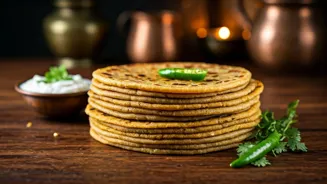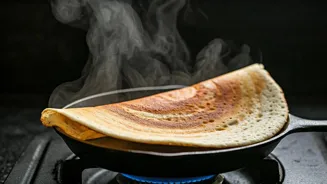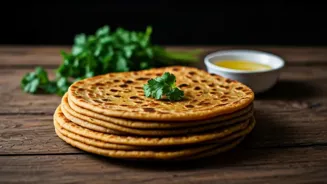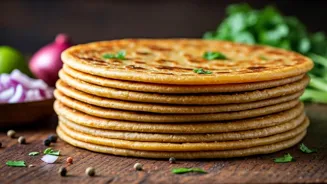The Humble Plain Paratha
The plain paratha forms the foundation of our paratha journey. It’s a simple yet satisfying flatbread, perfect on its own or paired with any dish. The key
to a good plain paratha lies in the dough and the cooking technique. The dough is typically made with whole wheat flour, water, salt, and sometimes a touch of oil or ghee for added richness. The dough must be kneaded thoroughly, allowing gluten to develop, resulting in a soft yet sturdy paratha. When cooking, a little ghee or oil is used to get a golden and crispy texture on the tawa, the traditional flat griddle used for cooking parathas. Mastering the plain paratha is the first step to become a paratha pro, and a perfect starting point for more elaborate variations.
Matar Paratha's Flavorful Twist
Let’s explore the vibrant world of matar paratha, a delectable variation bursting with flavor. This paratha features a savory filling of spiced mashed green peas. The preparation starts with cooking the peas until tender, then mashing them and adding spices such as ginger, green chilies, coriander, and sometimes a touch of garam masala, depending on personal preference. The spiced pea mixture is then enclosed in a wheat flour dough, rolled out, and cooked on a hot tawa with ghee or oil. The result is a paratha with a wonderful contrast between the soft, flavorful filling and the crispy, flaky exterior. This makes for a hearty and nutritious meal.
Mooli Paratha's Fresh Essence
Mooli paratha introduces a refreshing element with its main ingredient: radish (mooli). For this paratha, the radishes are grated and mixed with spices, similar to the method used for the matar paratha. The grated radish is often seasoned with salt, red chili powder, ajwain (carom seeds), and sometimes finely chopped green chilies and ginger. The radish filling provides a slightly pungent and crunchy texture. The filling is carefully enclosed in a rolled dough, and the paratha is cooked until golden brown, as with the other variations. Mooli paratha offers a different taste experience, with the radish's unique flavor profile providing a pleasing alternative to the more commonly found paratha fillings.




